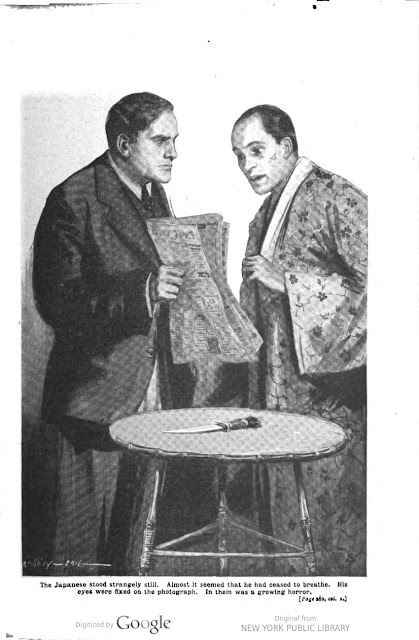SHERLOCK HOLMES must be the most pastiched and parodied fictional character in history, and, starting with the character's inception, more stories having fun with the Sage of Baker Street have been appearing all the time, with no end in sight. (See the amazing Sherlock Holmes Pastiche Characters megasite HERE.)
Unable to resist the temptation to send up Holmes, Augustus Wittfield gave us "The Star Detective of the Pole-to-Pole Railway," Carlock Bjones, and his faithful chronicler Watchem, in three mercifully brief parodies:
(1) "The Gold Coupler," The Railroad Man’s Magazine, July 1910 (below)
(2) "The Goat Degree," The Railroad Man’s Magazine, September 1910 (below)
(3) "The Alcohol Annihilator," The Railroad Man’s Magazine, March 1911 (below).
Wittfeld had several other short-lived series characters: Dorothy and Arthur for Top-Notch (6 stories), and Dugan (3 stories, one of them below), Loquacious Louie (2), and Monk Hausen (2) for The Railroad Man's Magazine. (Data from FictionMags.)
Are the Carlock Bjones tales funny? We say "fitfully so," but you might disagree. We're including them here purely for the sake of completeness.
~ ~ ~ ~ ~
"I am not baffled. I am never baffled. I may be perplexed, but not baffled. Perplexity is what gives zest to my art."
"The Gold Coupler."
By Augustus Wittfeld (1861?-1935?).
First appearance: The Railroad Man's Magazine, July 1910.
Short short short story (3 pages).
Online at Archive.org (HERE).
(Note: Faded text; click the "Zoom In" function 3 or 4 times.)
"The Star Detective Uses His Skill and Mental Telepathy to Penetrate a Mystery."
Someone has sent master detective Carlock Bjones a gold coupler and, while he insists he's never baffled, just who did it has him . . . perplexed . . .
* * *
"Watchem, will you never learn that it is unethical to ask a suspect to explain anything?
The proper course is to secure evidence, or, failing in this, to resort to the expedient of manufacturing evidence to fit the case."
"The Goat Degree."
By Augustus Wittfeld (1861?-1935?).
First appearance: The Railroad Man's Magazine, September 1910.
Reprinted in The Owosso (Michigan) Times, May 30, 1919 (HERE).
Short short short story (3 pages).
Online at Archive.org (HERE).
(Note: Faded text; click the "Zoom In" function a few times.)
"Carlock Bjones Follows a False Clue, and Finds That He Has Been Initiated into an Ancient Order."
Time is of the essence as supersleuth Bjones, being in the employ of the Pole-to-Pole Rail-way, tries to discover who was responsible for the disappearance of a box of Fat-Reducio
en route to Mr. O. B. C. Osofat . . .
* * *
"As Carlock's biographer, it was up to me to try and discover how and by whom he had been robbed of his wonderful discovery . . ."
"The Alcohol Annihilator."
By Augustus Wittfeld (1861?-1935?).
First appearance: The Railroad Man's Magazine, March 1911.
Short short short story (4 pages).
Online at Archive.org (HERE).
(Note: Faded text; click the "Zoom In" function a few times.)
"Carlock Bjones, Detective, Does Some Inventing as Well as Sleuthing, with the Customary Results."
A formidable chemist, Carlock Bjones synthesizes a compound which will revolutionize society—but there will always be elements of society that resist being revolutionized . . .
* * *
"Say, pardner, you don't happen to have a ticket to Pittsburgh in your clothes? I'm beginning to think New York is too strenuous for an humble bridge-worker."
"Dirk Johnson's Bank Robbery."
By Augustus Wittfeld (1861?-1935?).
First appearance: The Railroad Man's Magazine, November 1910.
Short short short story (4 pages).
Online at Archive.org (HERE).
(Note: Faded text; click the "Zoom In" function 3 or 4 times.)
"An Amateur Detective Gets a Hot Clue but Fails to Reap the Reward."
In one of his many stories of doubtful authenticity, Dugan regales Curran with an adventure starring Dirk Johnson, his trip up the outside of a skyscraper, and his eventful encounter
with "a lone robber, with a red Vandyke and a brace of blued steel barkers" . . .
Resources:
- Practically no information to speak of about Augustus Wittfield resides on the Interweb; everything we know comes from FictionMags.
The bottom line:



















































